Banana Flower
The banana flower is the actual flower of the banana tree. It is commonly eaten in Asia, but rarely ever seen in Western shops.
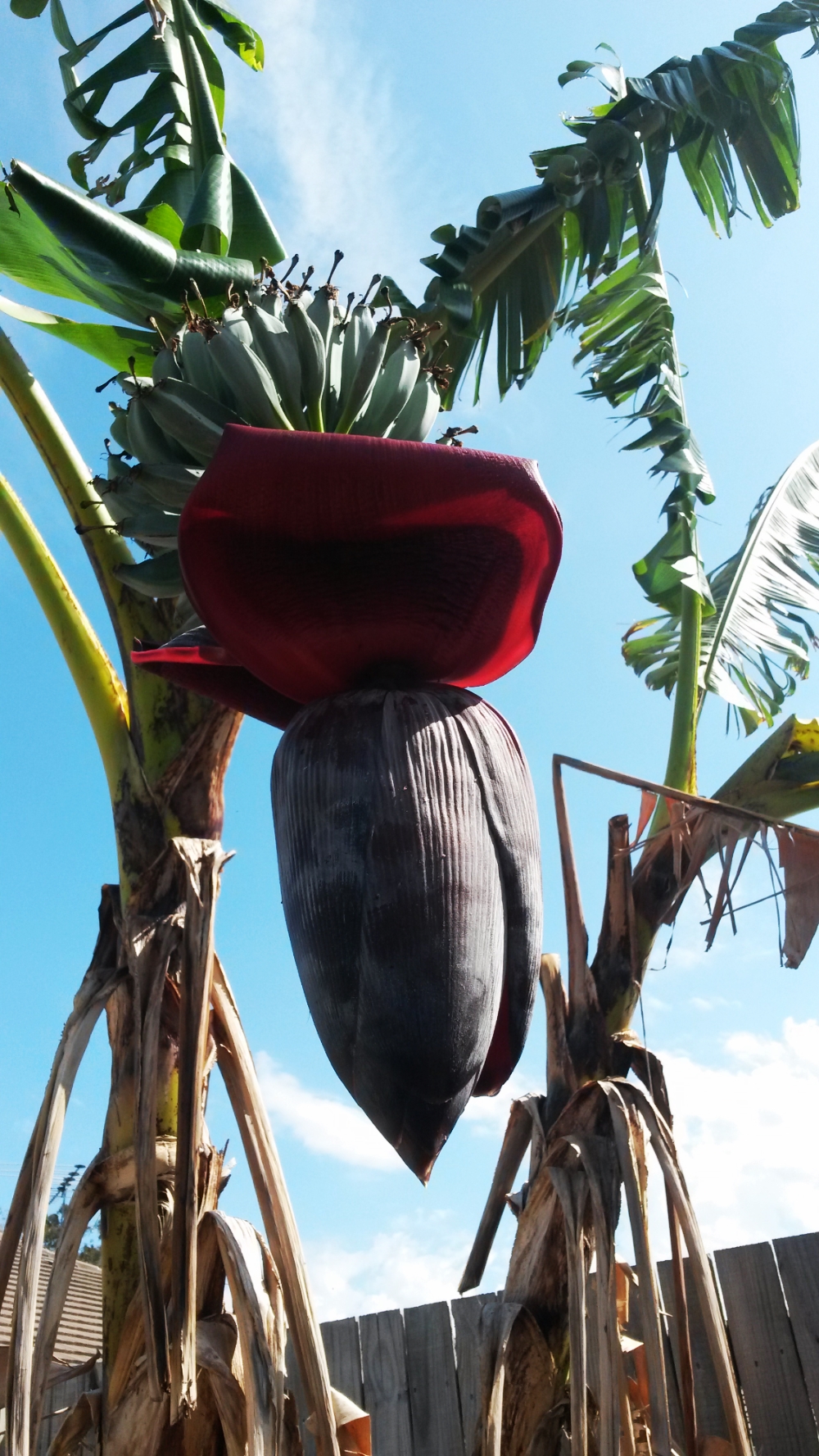
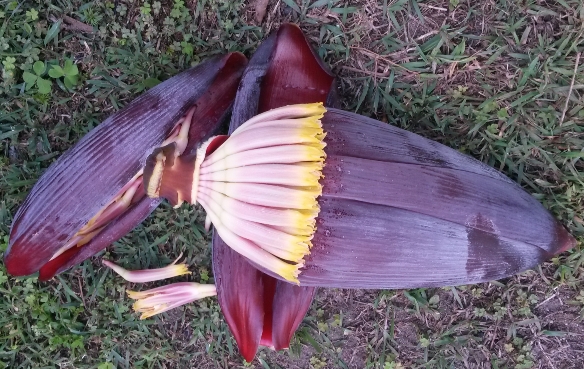
You can see by the structure of the flowers, how the flowers grow into a bunch of bananas.
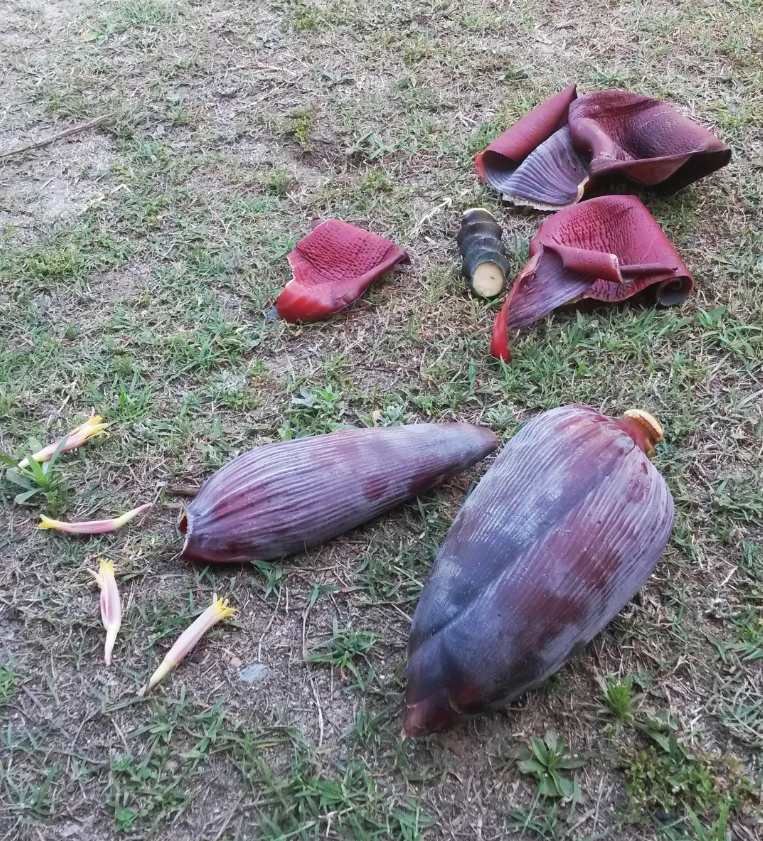 If you chop the banana flower down from your own tree, you need to be careful to avoid the milky sap. It is a good idea to let it lie on the ground for an hour or so to allow the sap to seep out and dry.
If you chop the banana flower down from your own tree, you need to be careful to avoid the milky sap. It is a good idea to let it lie on the ground for an hour or so to allow the sap to seep out and dry.
If you buy the flower in a shop, it most likely has been sitting there for some time. It is best to discard the most outer one or two leaves before rinsing the flower and cutting it up. If it has been sitting for a while the flower will also be less tender, and more fibrous to eat.
Discard the thick stem, and chop up the rest of the flower finely. It can then be added to a curry, or stir-fried. I think it is quickest to cook as a stir-fry with some oil, mustard seeds, salt, chilli and tamarind.
Jicama
The jicama (also known as the mexican yam bean) is a native to south america. But it has spread across East Asia and is now widely available in most asian groceries.
Unfortunately I forgot to photograph it before I started chopping it up, so imagine it with a light brown skin.
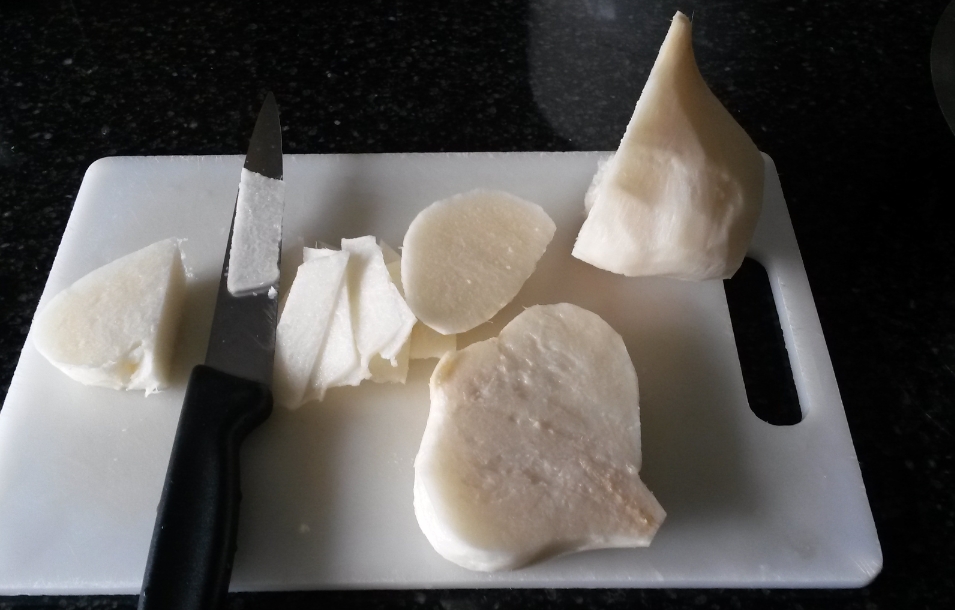
I sliced it up and tried it a few different ways. If you eat it raw it tastes likely a slightly more fibrous and milder version of a pear. I sauteed think slices quickly with a teaspoon of olive oil, salt, pepper and ground mustard seeds. Continuously stirring until the slices were soft. It was really quite yummy.
Since this yam is low calorie, high fibre and loaded with potassium.... I think I'll have to keep experimenting!
Kai Lan
This Asian green leafy vegetable is another of my favourites - seen here after a quick blanching in boiling water (I've blanched the thicker stems separately so they are hiding beneath the leaves).
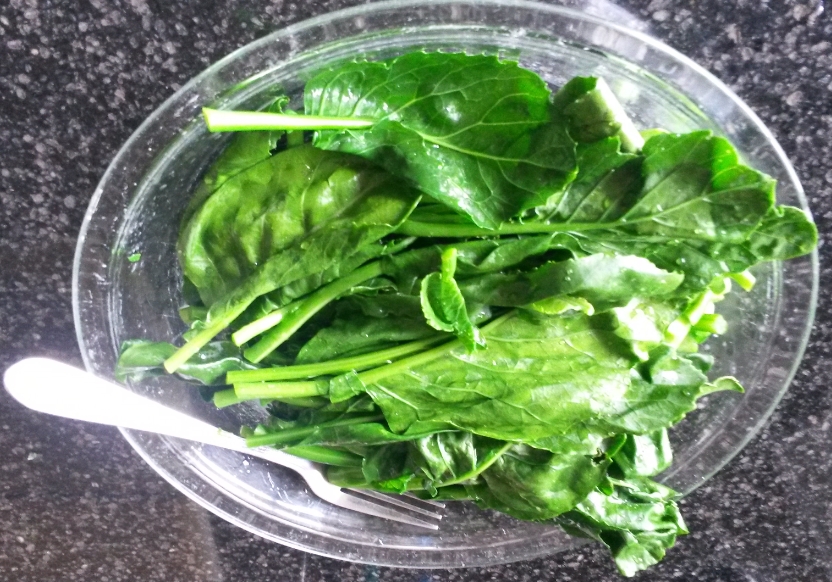
I could easily eat these with nothing more than a sprinkle of salt and pepper!
Kai-Lan is usually used in a stir-fry or else served just like this but doused in oyster sauce in Chinese restaurants. We can keep this dish vegetarian by making our own sauce, or else buying a vegetarian mushroom oyster sauce.
It is easy to find in Asian groceries and markets, and recently is becoming more common in the larger chain supermarkets as well.
It may also be known as "Chinese broccoli" or "Chinese kale".
Look for the freshest looking leaves. The leaves, flowers and stems are all edible. The stems do have a similar taste to broccoli, but I would much rather eat Kai-Lan than broccoli!
A great way to increase your intake of green leafy vegetables - and decrease your risk of diabetes!
Dark Roasted Curry Powder
- this curry powder is often used in Sri Lankan recipes. My favourite type is made by Larich and is available in most Sri Lankan/Indian grocery stores. It is often a quick way to spice up a curry without having to make an effort to consider which spices to use.However, to make your own try:
Ground coriander - 4 teaspoons
Ground cummin - 1 teaspoon
Ground pepper - 1/4 teaspon
Dried curry leaves - 5
Cinnamon powder -1/2 teaspoon
Dessicated coconut powder -1 teaspoon
-grind all the components together, and then dry roast in a hot frying pan (without any oil) until the spices turn a dark brown colour. Be sure to stir continuously so the spices roast evenly.
Kangkung
Kangkung Ipomoea aquatica (or asian water spinach) is a very common vegetable throughout Asia. It is easily located in most asian grocery stores.It is related to the morning glory flower, though to my knowledge the "morning glory" with it's beautiful blue flowers is not edible, while its relative with white flowers is edible.
It is nutritious and easy to cook, see the benefits extolled by the following website:
http://www.kangkungking.com/
It is also quite easy to grow, but requires moist soil with frequent watering. You can either order seeds from online stores such as http://www.greenharvest.com.au/seeds/VegetableLeafyGreens.html ; or you can plant some stems in the ground when you buy the leaves from a grocery store.
There are many asian recipes on the internet, but for a very simple recipe try the stir-fried leaves recipe.
Edible Leaves - Sweet Potato Leaves
Sweet Potato (Ipomoea batatas) is well known to most people, and easily available in most supermarkets. But did you know that the leaves are edible; and not only edible but very healthy and delicious.I had no idea until my mum served some for lunch! The young leaves and tendrils are picked and tend to stimulate the plant to grow even more leaves.
The plant is easy to grow - just put some tubers into the ground! (or into a pot if you want to have some control over where it grows) In fact, when you leave a sweet potato tuber in your kitchen, sometimes it starts to grow shoots before you get around to cooking it... so just bury it in the ground. If you can get hold of the leaves and stems in an asian grocery, then take a small piece of stem and bury the end in the ground and water. This plant gives you both yams and leaves to eat!
It does require a relatively sunny position, but not much watering. It grows very quickly, providing both leaves and tubers to eat. The tubers have a low glycaemic index compared to normal potatoes, have vitamin A, fibre and complex carbohydrates, the leaves are high in protein and fibre and other vitamins and minerals.
For more information see these websites:
http://www.fao.org/WAIRdocs/x5425e/x5425e0d.htm
http://marcsala.blogspot.com/2006/06/unusual-greens-part-3.html
http://www.happycow.net/blog/?p=52
The roots I think most people would be familiar with. The leaves taste much like Kangkung (a.k.a. asian water spinach), which is another member of the "morning glory" family. All the members of this family have very similar "morning glory" like flowers.
Try this stir-fried leaves recipe for sweet potato leaves courtesy of my mum.
Mushrooms
 They are fungi, and therefore neither plant nor animal.
They are fungi, and therefore neither plant nor animal.See this website for the nutrition profiles of mushrooms.
http://www.nhmrc.gov.au/_files_nhmrc/file/your_health/healthy/nutrition/cfg_submissions.pdf




Mushrooms have higher levels of the essential vitamins B2, B3, pantothenic acid and biotin than found in virtually all commonly eaten vegetables.
Mushrooms are the only non-animal, fresh food source of vitamin D. Subjecting mushrooms to a short amount of UV light elevates the vitamin D content to a level that will make them a significant source of this vitamin.
Mushrooms have higher levels of the essential minerals selenium and copper than found in commonly eaten vegetables. They also provide appreciable amounts of phosphorus and potassium.
The only thing they are not good for is vitamin B12!... don't believe the mushroom advertisements... the only B12 is contamination on the surface... which most of us wash off.
One antioxidant, ergothioneine, is found in higher levels in the mushroom than in any other food. The levels of ergothioneine in mushrooms is 12 times the amount found in wheat germ and four times the amount in chicken liver, the previous highest rated ergothioneine source before a recent study showed otherwise (Dubost 2006). There is no ergothioneine in vegetables.
It is interesting to note that the body has an ergothioneine transporter, suggesting that humans evolved with a regular consumption of ergothioneine containing foods like the mushroom (Grundemann 2005).
My favourite are the King Oyster mushrooms pictured. They taste similar to regular oyster mushrooms, but have a meatier, thicker texture.... and the best part is that being a relatively large mushroom they are quicker and easier to clean!
Of course regular button mushrooms are a staple. Swiss brown mushrooms taste quite similar to button mushrooms and I don't feel are worth the extra expense. Oyster mushrooms (pictured on the right), shiitake mushrooms, enoki mushrooms, shimeji mushrooms are all delicious!
I have trouble eating more than 3 fresh shiitake mushrooms (stomach pain), but no problems with the dried variety... I don't have an explanation for this, but I believe it is not uncommon to get some stomach ache from shiitake mushrooms. This doesn't prevent me from eating shiitake mushrooms!... but I'm careful not to eat too many at once.
I think regular consumption of mushrooms is a must for vegetarians.
Try these mushroom recipes.
Ridged Gourd
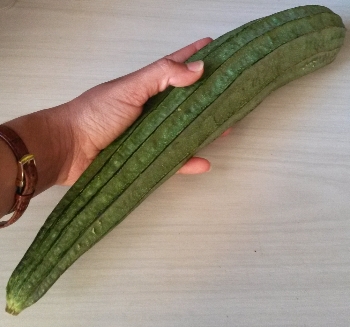
The ridged gourd is one of my favourite vegetables. It has many names the most common being "ridged gourd" and "angled luffa".
You may recognise the term luffa, as this gourd when over-ripe and dried out is used as an exfoliating sponge. In cuisine we cook with the young, unripe version.
To select the the gourd, look for a specimen with shiny skin and a soft bouncy feeling when squeezed. Of course you will only find this vegetable in asian groceries.
When it is cut open the flesh should be white and soft, the seeds should be soft similar to cucumber seeds.
It has a close relative the "smooth luffa" or " smooth gourd" which is very similar inside, but the skin is smoother and thinner. This might be better for most people if they don't like the crunchy skin of the ridged gourd so much.
I prefer to eat this as a "white curry".